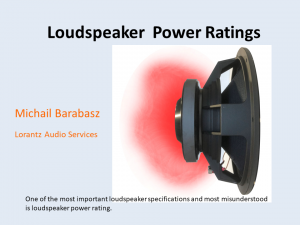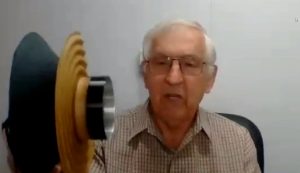On Monday December 13th the AES Melbourne Section mounted yet another Zoom online meeting.
Over thirty members and guests joined the meeting to hear Michail Barabasz of Lorantz Audio Services present on the topic of Loudspeaker Power Ratings

After welcoming everyone, Section Chair Graeme Huon introduced Michail who started his presentation with a brief history of his career at Plessey Rola (pre-1975), including and his involvement with the 1977 Australian Standard for Sound System Equipment (AS1127, Part 5 – Loudspeakers), before establishing Lorantz Audio Services in 1976.
After a short review of Ohms Law’s voltage, current and power relationship, Michail spoke of “loudspeaker” power versus real power (not the same thing, he commented).
He then showed an example of a Lorantz 12” bass-mid speaker with a power rating of 400 watts (per AES2-1984) and a program rating of 800 watts, remarking that 800 watts is just over 1 Horsepower, and is also the rating of a single bar of an electric heater.
He cited the torque power of a 1HP electric motor, and the fact that an 800W heater element with similar winding construction to a speaker voice coil emits significant heat and glows red hot.
He then covered the choice of amplifiers for doing speaker tests, indicating the challenge of maintaining the duty cycle required for testing, and that in real-world applications amplifiers of much higher power may be used, which definitely necessitates protection systems be built into the speaker system itself as the amplifier protection system may become ineffective under such lightly loaded conditions, necessitating that protection systems be built in to the loudspeakers themselves.
Michail went on to show the cone/voice-coil construction of his 12” example and commented that devices like this are commonly being driven by amplifiers with such power output capabilities that they could easily drive power tools like angle grinders (subject to achieving the required voltage conditions).
He expressed the fear that as professional speaker systems in commercial spaces become more lightweight but more powerful, the risks increase of overheating and potentially creating fire hazards.
He covered the factors that limit the power rating, citing factors like voice coil temperature rise, perceived distortion, diaphragm stress and cone displacement limits, as well as user practices and the type of program material (crest factor).
He then explained the multitude of standards for loudspeaker power rating, explaining that he still used the AES2-1984 Standard for consistency across his current and historical products. He explained in detail the procedure he uses for testing to that standard. He went on to speak on some of the theory of temperature rise in loudspeakers, and its implications.
He went on to describe typical speaker failure modes, through both thermal and mechanical causes, and displayed a free air speaker equivalent circuit demonstrating the elements involved.
He then showed diagrams of a speaker construction outlining the various techniques used to reduce temperature through forced convection and heatsinking, discussing their benefit of increasing the rated power against compromises like increased distortion.
He moved on to a chart displaying various heat dissipation strategies and the resultant improvements he measured, citing temperature rises of over 137°C in the best-case example.
He observed that Neodymium magnets experience Curie Effect problems at just 130°C
He showed examples of thermal damage to the voice coil, before pausing for questions.
There was a question from the audience about the quoted 2.37% efficiency, asking if the rest goes as heat. He answered that of 400 “loudspeaker watts”, 130W is “real” power of which all but 2.73% is dissipated – about 110W as heat, and the other (approx.)20W as eddy currents, mechanical, and windage losses.
Michail returned to his slides to discuss mechanical damage scenarios, describing examples of the voice coil excessive excursion (moving out of the pole or bottoming out), cone and surround damage, and the spider clashing with the front-plate or frame.
He showed a graph charting the voice coil excursion increasing as the frequency decreases, indicating that damage can occur at very low frequencies at a much lower power level.
He then showed examples of cone failure at the perimeter from excessive stress, as well as in the cone itself.
He went on to show some results for his 15” loudspeaker and discussed the selection of a starting frequency for the test, based on the excursion limit of that particular device.
He then discussed the Klippel test software he uses, showing some voice coil temperature and resistance charts plotted against time which help him establish the AES power rating.
He then showed a voice coil pre and post-test, showing the blackening of the winding from overheating.

He emphasized that the AES rating is the maximum power that the loudspeaker can endure for 2 hours and noted that it certainly cannot endure this treatment at lower frequencies, necessitating a high-pass filter.
He then covered some practical considerations in conducting the loudspeaker tests, like acoustic noise being generated at high level for the 2 hours of the test necessitating a dedicated test room, as well as the need to control ambient conditions. He noted that amplifiers are often not robust enough to handle the heavy duty-cycle of the test, so are prone to failure. Then there is the time needed to do a full test.
He went on to indicate some topics that the AES test does not address, such as the distortion level, stress fatigue, the acoustic load, the end user (source content – speech or type of music), end use (HiFi vs Professional use), and safety considerations.
Michail went on to show some high stress use cases where the speaker should be derated such as where box design or placement increase the heat rise, or where there is a non-symmetric acoustic load.
He then covered the dangers associated with driver failures in passive crossover situations, where a failure can result in dangerous overheating of crossover inductors and covered some protection strategies to cover these cases.
He also showed a curve of diaphragm excursion vs frequency for a vented system, showing the dramatic increase in excursion at extreme low frequencies, necessitating a high-pass filter to protect the driver.
Michail then briefly described an excursion protection system using DSP to realize a dynamic high-pass filter where the Q and high-pass frequency are signal dependent, as well as a DSP-based active heat protection system.
As his talk wound up, he described the ANSI/CEA-2010 Standard for measurement of powered subwoofers and indicated that, although this Standard was for consumer devices, it had some elements which could be of use for the professional audio environment.
He concluded his presentation by stating that the AES power test is a demanding test testing the speaker’s build integrity and thermal capabilities, however the end use, customer safety and fidelity acceptance also need to be considered.
At the end of his talk Michail fielded questions on a range of topics, including temperature effects on coil former types, as well as neodymium magnet material, as well as its annealing effect.
There was also a question on recommended amplifier sizing.
A discussion also ensued about the potential combustion point of wooden speaker boxes, and the safety hazard this presents in this environment of componentry operating at abnormally high temperatures.
A video recording of the Zoom session has been created. An edited version is below:
This video can be viewed directly on YouTube at: https://youtu.be/cyURXvmndnk
A PDF version of Michail’s slides is available at:
https://www.aesmelbourne.org.au/wp-content/media/AES-Dec2021-final.pdf
Links:
Lorantz Audio: https://www.lorantz.com.au/
AES2 Standard (revised 2012): https://www.aes.org/publications/standards/search.cfm?docID=12
Free to AES Members, available for purchase by others.

